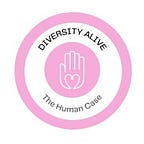What is this thing they call diversity & inclusion?
We said we are on a mission! We wish to debunk some of the traditional thinking around Diversity & inclusion by getting to the heart of the matter; we’re getting back to the humans that are Diversity Alive. We’ve conducted a series of interviews with individuals who get it. Those folks who live the journey every day seamlessly, and the results have been incredibly eye-opening.
You can read our first blog here. Now the mission continues as we dive deeply into defining this concept a bit differently…
Research Question 2: What is your personal definition of Diversity and inclusion?
A common understanding begins with the language of D&I. Maya Angelo stated, “when you know better, you do better.” Understanding what ‘real’ definitions of Diversity and Inclusion are, we then understand the subject as more significant than just standard labels often associated with the workplace environment. When we create a joint base of understanding, we eliminate the compliance aspect associated with Diversity and Inclusion. It begins with reducing the fear, fear being the single most significant barrier to the Diversity and Inclusion conversation. Fear that “I don’t know what I am talking about” or “I don’t want to be offensive” can result in the much-needed conversation never materializing.
Although Diversity is a widely discussed and debated topic these days and movements such as Black Lives Matter and #Heforshe magnified the need for open and honest discussions in this regard, the conversation still often centers purely on one element of the topic. The reality is that the subject of D&I is not fully understood nor interpreted clearly, and many transformation/diversity/inclusion initiatives fail. Companies grapple with the topic and become stuck trying to fit it into pre-existing structures that drive a heavy ‘compliance feel.’ We still lack a common language to facilitate a meaningful and effective conversation.
Clear definitions can create this common language for organizations and individuals alike and allow us to build the much-needed muscle to have complex and often tricky conversations. When definitions clearly articulated and understood materialize, it starts to educate, enlighten, stir empathy, create curiosity and foster courageous leadership. It allows individuals to lean in and to be more curious. It eliminates the defensive attitudes towards this rich subject.
Diversity is more than a conversation; it’s a relationship.
Academically we can define Diversity as “the practice or quality of including or involving people from a range of different social and ethnic backgrounds and of different genders, sexual orientations…” It all feels so impersonal.
Our research has unearthed a deeper, richer narrative, a set of Human orientated definitions. The quotes in all our blogs are not our own; they are the wisdom of the individuals who participated in our research. The definitions emerge from individuals’ souls and our collective need to be seen.
“It’s about anything that can introduce a broadening of understanding. The stuff that happens in honest relationships…underpinned by a belief and a feeling, an understanding that we are equal even when we are not the same.”
Embracing Diversity begins with me.
“Diversity is the ability to find the purest part in another human being, regardless of their race, sex, which country they come from, or your ability to connect with the essence of that person.”
Inclusion allows a step deeper. “Being able to create an environment that allows those differences to co-exist and thrive.” It’s in that ability to thrive that magic begins to happen when we allow the freedom for “people to just be who they have always been.”
“Inclusion is a matter of individuality — acceptance of individuality. Wounded individuality, striving individuality — that is inclusion. It is acceptance of yourself — let your freak flag fly — as long as you are not oppressing anybody else. I respect your right to be you without judgment.” Inherent in this is the realization that “you need to be ok with discomfort.”
It’s all about flying your flag with pride but without prejudice. To be inclusive is the acceptance of individuality, yours, and others. It starts with an acute awareness of oneself. Diversity thrives in self-expression. It begins with realizing that we need to be the change we wish to happen.
Facilitation and recognition are paramount.
There is generosity in the definitions, an activity, a responsibility. “At the end of the day, you cannot have a perfectly diverse anything.”
“Diversity & inclusion requires recognizing. Recognizing that we are all very different but that our contributions are equally important. That we are all equally accountable when we come together. That everybody not only feels that they have the space to contribute, but that their contribution counts.”
Diversity is the facilitation of bringing very different people together to be heard. It is undoubtedly not about rules or guidelines, nor is it a conversation about perfection. It’s difficult. There ain’t no cupcakes and rainbows!
Mi Casa Su Casa
Perhaps this definition sums it up best — “Diversity is like Mi Casa Su Casa, whoever you are, you are welcome in my home. Inclusion is when you feel comfortable being there.”
This representation of different views and skills to co-exist and thrive provides the space for richness. It creates a space for mutual respect.
Diversity and inclusion are what it means to be human.
Let us start with being human.
